| May-15-04 | | Tigran Petrosian: Alapin seemed to miss the spectacular 24.g4!! and if 24..Qxg4 then the thunderbolt 25.Bd5!!. The same thing happens if black takes with the rook. |
|
| May-15-04 | | fantasticplastic: Alapin was a pretty fat chess player by any standards...=) |
|
May-16-04
 | | Chessical: <TigranPetrosian> Your move <24.g4> is very strong, exploiting the unexpected interference of the B on d5 to protect <f3>. <24.g4> Qxg4 25.Bd5 Qxf5 26.Bxc6 Rxc6 27.Bxb6 axb6 when White has the initiative and a piece for two pawns. With <22.Nf5?> Chigorin calculated a complex counter-attacking possibility. This he chose, instead of the playing the defensive reteat <22...Rdd8> which would have given White lasting pressure. Unfortunately, for Chigorin there was a subtle trap which he fell into. Perhaps a draw was the "correct" result as Alapin did not see <24.g4> either. |
|
| May-16-04 | | Tigran Petrosian: Thank you for confirming my kibitz. |
|
| Oct-02-04 | | misguidedaggression: Sorry guys, 24.g4? loses to Rxh2+!
25.Qxh2 Bxf3+ 26.Kg1 Qxg4+ 27.Kf1 (Kf2 is met by the same but loses faster) Bc7! (There was a good reason for 24.Bxb6) 28.Qg1 Bg3 29.Rc2 (the only way to stop Qh3+) Rxc4 30.Rd2 h4 and white is in trouble. |
|
| Oct-02-04 | | misguidedaggression: Or better yet, 30...Qh3+ 31.Rg2 Qxg2 32.Qxg2 Bxg2 33.Kxg2 Bxe1 simplifies into a won endgame. |
|
| Oct-03-04 | | Kean: 5.Qa4 and all the variation to get back the pawn seems passive and only gives black a playable game, by move 11 all is fine to black. |
|
| Oct-04-04 | | Rowson: Is blacks 4.Na5!? considered sound? i think i would have insinctivly played 4.Ne5. |
|
| Oct-04-04 | | clocked: <misguidedaggression> Sorry, your line doesn't work because your bishop on c7 is pinned after the bishop moves. 28.Be2 |
|
Oct-04-04
 | | tamar: For a comparison with 4...Ne5, see how Morozevich puts his knight en prise with 21...Nf5 and continues the thematic K-side attack far into a queening endgame. Blindfold of course! Chigorin would be proud. Ljubojevic vs Morozevich, 2002 |
|
| Oct-08-04 | | misguidedaggression: I saw Be2, but I didn't think white would play it so soon, looks like there should still be something there, but I can't see it. I guess I'll just have to admit defeat. :P |
|
Aug-16-20
 | | KEG: This replay of the Round 6 draw between Tchigorin and Alapin was played the day before the 13th and final Round at Monte Carlo 1901. As of the time the game was played, Tchigorin was the only player with even a mathematical chance of catching tournament leader Janowski. A win would have brought Janowski to within a half-point of Janowski. A draw meant that Tchigorin would be 0.75 points behind and thus that Janowski would win the event unless he lost to Marco in the final round either in the initial game or in a replay (and all this, only if Tchigorin defeated Mieses in the last round). Accordingly, Tchigorin had to play for a win. Based on the prior record between Tchigorin and Alapin, the former obviously was a favorite. Tchigorin defeated Alapin in each of the first ten games they played. After that, they played three more times before Monte Carlo, Tchigorin winning once and drawing the other two. Their game in Round 6 at Monte Carlo ended in a draw, hence the need for this replay. All this explains some of what happened in the game. Alapin avoided sharp lines in the opening (including a line he knew well) while Tchigorin tried valiantly to complicate. The crucial moment in the game came on Tchigorin's 22nd turn, in which he boldly sacrificed a piece. His idea was clever but flawed, the tournament book's comments notwithstanding. As pointed out on this site by <Tigran Petrosian>, and as demonstrated by <Chessical>, Alapin could have won on move 24. with 24. g4! <misguidedaggression< has presented a brilliant response to 24. g4 which he claims wins for Black, but as will be seen, the brilliant line he presents has a flaw. After Alapin's 24. BxB, Tchigoring had to play a brilliant drawing combo leading to perpetual check to avoid loss. With this draw, Janowski's victory at Monte Carlo 1901 (his first major tournament win) was very much in sight. 1. d4 d5
2. c4 Nc6
Tchigorin's favorite.
3. Nc3 dxc4
The most usual line. 3...e6 and 3...Nf6 were perhaps most accurate, but Tchigorin knew the variations arising from the text well. And--as it turned out--so did Alapin. 4. d5
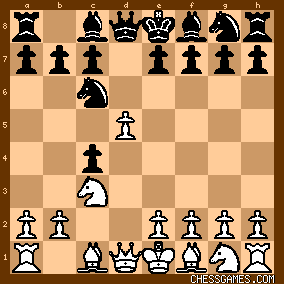
click for larger view4... Na5?!
The context here is critical. The most usual (and probably best) move here for Black is 4...Ne5. Indeed, <Romson> quite appropriately says "I would have instinctively played 4...Ne5. But there was crucial history involved here. The text was introduced by Tchigorin in a game against Walbrodt at Vienna 1898 (which Tchigorin lost). Then, in 1899, the move was played again in a consultation game (ultimately drawn) between a team from Vienna (which included Alapin) and a team from St. Petersburg (which included Tchigorin). Thus, Alapin and Tchigorin knew this variation.
Tchigorin played the move again in 1900 against Lebedev (in a game Tchigorin won). The question was, had one of the players found an improvement. 5. Qa4+
The simple (and best) way to regain the pawn. <Kean> calls this "passive," but does not suggest anything better. To the extent Alapin backed off and avoided the critical lines, this occurred on his next move. 5... c6
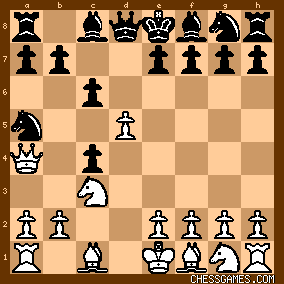
click for larger viewThe first crisis of the game had arrived. Should White (Alapin) play to win the Black Knight on a5 with 6. b4 (at the cost of a couple of pawns and a badly mangled pawn structure), or should he play it safe and head for equality with 6. dxc6. At Vienna 1898, Walbrodt played it safe with 6. dxc6 (and eventually won). In the Vienna-St. Petersburg game, White (Vienna with Alapin) decided to snatch the piece with 6. b4. Both players knew 6. b4 was an option. But Alapin had to wonder whether Tchigorin had something planned. What would you do as White here? |
|
Aug-16-20
 | | KEG: Post II
6. cxd6
Following the lead of Walbrodt and taking the safe route. But what about 6. b4. In the 1899 Vienna-St. Petersburg consultation game, play had gone 6. b4 b5 7. QxN QxQ 8. bxQ b4 9. Nd1 cxd5 10. e4 e6 leaving: 
click for larger viewThis left White "...winning the piece, but for four pawns on the queen's side in a bargain of doubtful value." (Monte Carlo 1901 tournament Book). Perhaps the views of Alapin and of the Tournament Book and of the Tournament Book were colored by the fact that the Vienna team played the tentative 11. Ne3 in the above diagrammed position, allowing Black to come out OK with 11...Nf6. But with 11. exd5 or 11. Ne2, White seems to have excellent winning chances. After all, a piece is a piece. The Tournament Book suggested that Alapin avoided the above line, fearing that Tchigorin had some prepared variation in store for him. But let's look a little more deeply into the position after 6. b4: 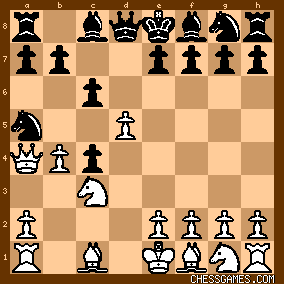
click for larger viewPerhaps Alapin was concerned about lines beginning with 6...cxb3 e.p. (instead of 6...b5). Play would then continue 7. axb3 e6 8. Bd2 (not 8. QxN?? QxQ 9. RxQ Bb4 and Black wins) b6 leaving White another crucial decision. He could play to win the piece with 9. b4 exd5 10. bxN b5 11. Qd4 Be7 12. Nf3 Nf6 13. Ne5 Qd6 14. Bf4 Nh5 15. Be3 Be6 16. Nd3 with Black holding two pawns for the piece in an unclear position. Alternatively, he could try to play it safe with 9. dxc6 Ne7 10. c7+ Qd7 11. Nb5 Nac6 12. Rd1 with even material and a small edge for White. Given Alapin's history of being thrashed by Tchigorin,and given the danger of ever taking on Tchigorin in a tactical shoot-out, Alapin's decision to keep it simple was certainly understandable. So let's get back to the actual position after Alapin's 6. dxc6: 6... Nxc6
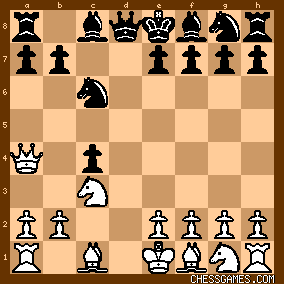
click for larger view7. e4
In his game against Tchigoring at Vienna 1898, Walbrodt played 7. e3. Alapin's move certainly looks better. 7... Bd7
8. Bxc4 e6
9. Nf3 Rc8
10. Qd1
10. Be2 looks more enterprising, but the text was certainly reasonable and sufficient for at least equal chances, the position now being: 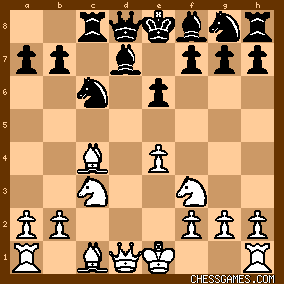
click for larger viewCaution had been Alapin's policy throughout the tournament. He was the only player to have only one loss. He had, however, drawn a bunch of games, and was now only in 5th place (where he would finish). But Tchigorin needed a win if he wanted to catch Janowski, so he now started to go all out even if it meant taking risks: 10... Bb4
The sound choices were 10...Nf6 and 10...Qc7. The text was a way to generate some action. 11. 0-0
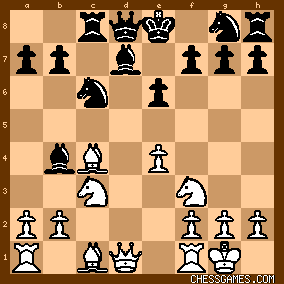
click for larger viewIn this position, Tchigorin decided to cross the Rubicon, and things became very complicated and very interesting. |
|
Aug-18-20
 | | KEG: Post III
11... Qa5?!
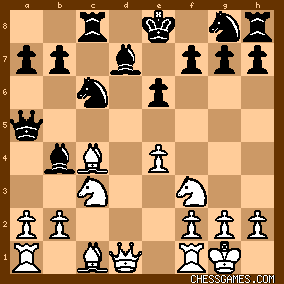
click for larger view"Not with the intention of capturing the Knight, but to gain time to bring the Queen over to the King's side." (Tournament Book) But this could have led to trouble for Tchigorin if Alapin had kept his head. The simple 11...Nf6 (or maybe 11...a6 or 11...h6) would have been sounder and left Black in decent shape, even though White (being better developed and with no major weaknesses) would be slightly better. 12. Qe2
Very tentative. Alapin could have created problems for Tchigorin with 12. Bd2. The text, however, set a little trap. Had Tchigorin played to win a pawn with 12...BxN 13. bxB Qxc3? (Black would be very much still in the game with 13...Nf6, though the 12... BxN trade would still haunt him a bit) Alapin would have had a win--as the Tournament Book pointed out-- with 14. Bb2 Nd4 (obviously the only chance here) 15. NxN QxB 16. QxQ RxQ 17. Nxe6! f6. 18. Nxg7+. 12... Nge7
Avoiding the trap, but missing the chance to equalize with 12...Ne5. 12...Nf6 was also significantly better than the text. 13. Bd2
This would have been best one move earlier. Here, Alapin had a stronger choice: 13. Be3, 13... Ne5
14. NxN QxN

click for larger view15. Kh1
Alapin's fear of Tchigorin continues to show. Instead of this passive move, he could have tried to force play with 15. a3, or perhaps try 15. Rfd1. Alternatively, Alapin might have played 15. g3 (with a view to a later Bf4). 15... 0-0
Tchigorin had now achieved an decent position with approximately equal chances: 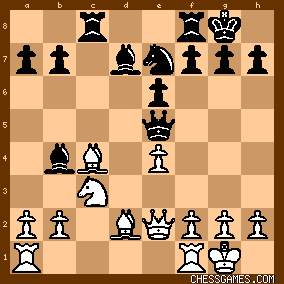
click for larger view16. a3
"16. f4 at once would be answered by 16...Qd4." (Tournament Book). I don't understand this comment at all. Both 16. a3 and 16. f4 were reasonable choices. If 16. f4 Qd4, White simply plays 17. Bb3 with some chances. Better after 16. f4 would be 16...Qc7 or 16...Qc5. 16... Ba5
Hard to understand why Tchigorin rejected the seemingly obvious (and better) 16...Bc5. After the text, Alapin could have obtained the better game with 17. f4 or 17. Bd3. 17. b4?
Driving the Black Bishop to a better square.
17... Bb6
18. Rac1 Rfd8
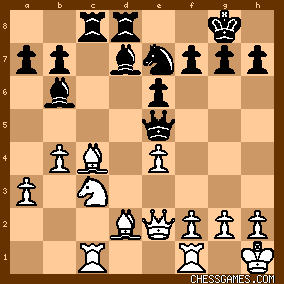
click for larger viewIn this position, Alapin lost his way and gave Tchigorin chances he failed to seize. |
|
Aug-19-20
 | | KEG: Post IV
19. Nb1?
"The only square for the Knight, and a good move appreciative of the situation." (Tournament Book) The Tournament Book notwithstanding, text was in fact very weak and tentative and (by abandoning control of b5) left White open to a tactical stroke that would have given Black close to a strategically winning position. Best was 19. b5. Alternatively, and if Alapin was worried about Tchigorin's pressure on the c-file, he could simply have played 19. Bb3 or 19. Ba2. The position after 19. Nb1? was:
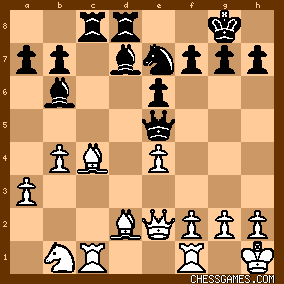
click for larger view19... Bc6?
Missing the powerful shot 19...RxB! Play could then have continued 20. RxR Bb5 21. Bc3 Qd6 (better than 21...Qf4 22. a4!) 22. Kg1 Qd3 23. QxQ RxQ 24. Rc5 (best) BxR 25. bxB f5 26. exf5 exf5 after which, despite Bishops of opposite colors, White would have his work cut out to save the game. The text blocked the c-file for Black and gave Alapin a chance to come close to restoring the balance. 20. Rfe1
20. f3 was much better. After the text, the position was: 
click for larger view20... Rd4?!
"!"--(Tournament Book)
"Apparently a hazardous move, but in reality the initial of Black's final combination; evidently he cannot wait any longer, for b5 dislodging one of the well-placed bishops, and f4 are threatened." (Tournament Book) Among the problems with the Tournament Book's analysis is that the upcoming combination towards which Tchigorin was aiming had a fatal flaw (as will be discussed when we consider the win Alapin missed on move 24). Given the key importance of b5, best for Black here was 20...a6! After the text, the danger for White had passed. 21. f3
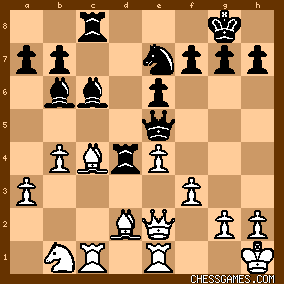
click for larger view21... Qh5
Not terrible in and of itself, but the prelude to a flawed combination. Simpler a d sufficient for equality were 21...Rdd8 pr 21...Bc7. But Tchigorin was not looking for a draw. 22. Be3
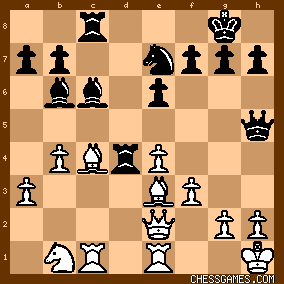
click for larger viewThe key moment in the game had been reached. It was here that Tchigorin launched his brilliant--but as it turns out flawed--combination. |
|
Aug-19-20
 | | KEG: Post V
22... Nf5?!

click for larger view"!"--(Tournament Book)
"?"--(<Chessical>) "This pretty move Tchigorin had in view when playing Rd4. It is to be regretted that it has no better result than a perpetual attack." (Tournament Book) "With 22,,,Bf5? Tchigorin calculated a complex counter-attacking possibility. This he chose, instead of playing the defensive retort 22...Rdd8 [best--KEG] which would have given White lasting pressure. Unfortunately, there was a subtle trap he fell into." Tchigorin's idea was indeed brilliant. His move threatens Ng3+ winning the White Queen. White's only way to obtain an edge now was to capture the Knight (23. Bf4 which guards against Ng3 was sufficient for equality). But this allows the Rook to swing over to h4 establishing a dangerous attack on h2. Alapin's line forced a draw by perpetual check. However, as <Tigran Petrosian> has pointed out and as <Chessical> has demonstrated, there was a "subtle flaw" that could have handed a win to Alapin. This line was hard to find over the board, so as played, the brilliant text led to a draw. As a theoretical matter, as <Chessical> has noted, best for Black here was 22...Rdd8, which should have allowed him to hold the game, although as <Chessical> has also pointed out, White would enjoy some binding pressure on the position. 22...Rd6 was probably also sufficient to hold the game. The text, however, was far more thrilling, even if there is a fly in the ointment. 23. exN Rh4
This left the following critical position:

click for larger view24. BxB
This eliminates Tchigorin's dark-square Bishop and forces a draw. But was there anything better? We can dispose of 24. h3? As the Tournament Book pointed out, this loses to 24...Rxh3+! [i.e., 25. gxR (25. Kg1 leads to mate in three: 25...Rh1+ 26. Kf2 Qh4+ 27. g3 Qh2 mate) Bxf3+ 26. Kh2 BxQ 27. BxB RxR 28 BxQ Bc7+ 29. Kg2 RxR with a fork of the White Knight and Bishop guaranteeing the gain of a piece and a win. Alternatively, in the above line, if 26. QxB QxQ+ 27. Kh2 BxB 28. RxB Qf2+ 29. Kh1 QxR. But White did have a win here with 24. g4! The analysis of this move by<Chessical> is decisive: 24...Qxg4 (best) 25. Bd5 Qxf5 26. BxB RxB [26...bxB 27. Nd2 would be even worse for Black--KEG] 27. BxB [27. Nd2 is probably even stronger--KEG] axB (with 28.Nd2 to follow). <misguidedaggression> nonetheless claims that 24. g4 loses to 24...Rxh2+. This is another brilliant idea. But like that of Tchigorin, it has a flaw: 24...Rxh2+ 25. QxR Bxf3+ 26. Kg1 Qxg4+ leaving: 
click for larger view<misguidedaggression> claims a win for Black here whether White plays 27. Kf1 or 27. Kf2. But: A) 27. Kf1 (best) Bc7 ["!"--<misguidedaggression>] and now 28. Qg1? as given by <misguidedaggression> does indeed lose to 28...Bg3; but 28. Be2! wins for White, since Black can not snatch the White Queen with 28...BxQ in light of the back-rank mate via 29. RxR mate. B) 27. Kf2 also wins for White after 27...Bc7 28. Be2! creating the same devastating pin of the Black Bishop on c7. So 24. g4! would have won. But Alapin played 24. BxB, leaving the position as follows: 
click for larger viewThe finish--though a draw by force--was nonetheless exciting. |
|
Aug-19-20
 | | KEG: Post VI
24... Rxg2+
There was obviously no time for 24...axB in light of 25. Qe5 guarding h2 and leaving White a piece up in a winning position. 25. Kg1 axB
"The loss of time involved in this necessary capture saves White's game." (Tournament Book) Point taken, though Black can also draw with 25...Qh4 26. Kf1 (forced) axB 27. Qf2 (forced) Be8 (27...Ba4 also works) 28. fxe6 (or 28. QxQ immediately) RxB! 29. QxQ RhxQ 30. exf7+ Kxf7 31. Kf2 b5 after which Black (despite his doubled b-pawn, should be able to survive). After 25...axB the position was:
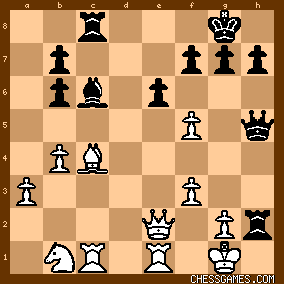
click for larger view26. fxe6 Rh1+ (forced)
27. Kf2 Qh4+
The only move to save the game, but it works!:
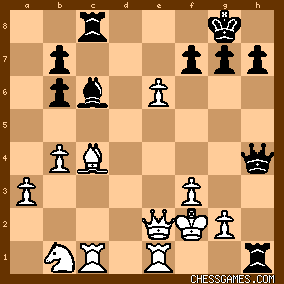
click for larger view28. Ke3 Rd8 (forced)
"This pretty move secures the draw." (Tournament Book) 29. Rcd1
29. exf7+ Kf8 (forced) 30. Rxd1 Qg5+ 31. Kf2 (forced) Qh4+ 32. Ke3 Qg5+ also leads to a draw by perpetual check. 29... Qg5+
Or 29...Qh6+
30. Kf2 (forced) Qh4+ (forced)
31. Ke3 (forced) Qg5+
32. Kf2
Drawn |
|
|
|
|





